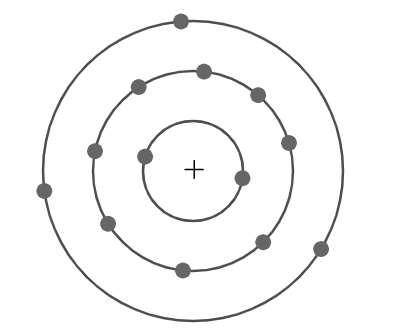
The symbol of the aluminium atom is
Atomic number
Mass number
Number of protons
Number of electrons
Number of neutrons
Electronic configuration


Answer
416.7k+ views
Hint : In order to solve this question, we should know about the basics of the Bohr atomic model, Bohr suggested that electrons of an atom revolve in circular orbit around the nucleus of an atom. Nucleus contains protons and neutrons and electrons are distributed in a quantized manner in different orbits of an atom. We will use this concept and from the diagram we will find all the parameters asked in the question.
Complete Step By Step Answer:
When an atom is represented as
Since, we also know the number of protons in an atom is equal to the number of electrons and this number is known as atomic number.
Mass number is the sum of the number of protons and number of neutrons in the nucleus of an atom.
Electronic configuration represents how the electrons of an atom are distributed in successive orbits of an atom.
So, from the given symbol of aluminium
Atomic number is given as
This atomic number will equal the number of protons and the number of electrons.
Mass number is given as
Now, since mass number is the sum of number of proton which is
Or
Hence, number of neutrons are
Now, from the given figure we can see that, two electrons are distributed in the first orbit around the nucleus of an aluminium atom and then eight electrons are distributed in the next orbit and later three electrons are distributed in the last orbit.
So, electronic configuration can simply be written in the form of the number of electrons in successive orbits.
Hence,
Atomic number
Mass number
Number of protons
Number of electrons
Number of neutrons
Electronic configuration
Note :
It should be remembered that, maximum number of electrons an orbit can have according to Bohr’s atomic model can be calculated using formula
Complete Step By Step Answer:
When an atom is represented as
Since, we also know the number of protons in an atom is equal to the number of electrons and this number is known as atomic number.
Mass number is the sum of the number of protons and number of neutrons in the nucleus of an atom.
Electronic configuration represents how the electrons of an atom are distributed in successive orbits of an atom.
So, from the given symbol of aluminium
Atomic number is given as
This atomic number will equal the number of protons and the number of electrons.
Mass number is given as
Now, since mass number is the sum of number of proton which is
Or
Hence, number of neutrons are
Now, from the given figure we can see that, two electrons are distributed in the first orbit around the nucleus of an aluminium atom and then eight electrons are distributed in the next orbit and later three electrons are distributed in the last orbit.
So, electronic configuration can simply be written in the form of the number of electrons in successive orbits.
Hence,
Atomic number
Mass number
Number of protons
Number of electrons
Number of neutrons
Electronic configuration
Note :
It should be remembered that, maximum number of electrons an orbit can have according to Bohr’s atomic model can be calculated using formula
Recently Updated Pages
Master Class 11 Economics: Engaging Questions & Answers for Success

Master Class 11 Business Studies: Engaging Questions & Answers for Success

Master Class 11 Accountancy: Engaging Questions & Answers for Success

Master Class 11 English: Engaging Questions & Answers for Success

Master Class 11 Computer Science: Engaging Questions & Answers for Success

Master Class 11 Maths: Engaging Questions & Answers for Success

Trending doubts
State and prove Bernoullis theorem class 11 physics CBSE

1 ton equals to A 100 kg B 1000 kg C 10 kg D 10000 class 11 physics CBSE

State the laws of reflection of light

One Metric ton is equal to kg A 10000 B 1000 C 100 class 11 physics CBSE

1 Quintal is equal to a 110 kg b 10 kg c 100kg d 1000 class 11 physics CBSE

Difference Between Prokaryotic Cells and Eukaryotic Cells




